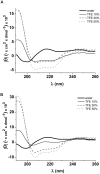Activity of Scorpion Venom-Derived Antifungal Peptides against Planktonic Cells of Candida spp. and Cryptococcus neoformans and Candida albicans Biofilms
- PMID: 27917162
- PMCID: PMC5114273
- DOI: 10.3389/fmicb.2016.01844
Activity of Scorpion Venom-Derived Antifungal Peptides against Planktonic Cells of Candida spp. and Cryptococcus neoformans and Candida albicans Biofilms
Abstract
The incidence of fungal infections has been increasing in the last decades, while the number of available antifungal classes remains the same. The natural and acquired resistance of some fungal species to available therapies, associated with the high toxicity of these drugs on the present scenario and makes an imperative of the search for new, more efficient and less toxic therapeutic choices. Antimicrobial peptides (AMPs) are a potential class of antimicrobial drugs consisting of evolutionarily conserved multifunctional molecules with both microbicidal and immunomodulatory properties being part of the innate immune response of diverse organisms. In this study, we evaluated 11 scorpion-venom derived non-disulfide-bridged peptides against Cryptococcus neoformans and Candida spp., which are important human pathogens. Seven of them, including two novel molecules, showed activity against both genera with minimum inhibitory concentration values ranging from 3.12 to 200 μM and an analogous activity against Candida albicans biofilms. Most of the peptides presented low hemolytic and cytotoxic activity against mammalian cells. Modifications in the primary peptide sequence, as revealed by in silico and circular dichroism analyses of the most promising peptides, underscored the importance of cationicity for their antimicrobial activity as well as the amphipathicity of these molecules and their tendency to form alpha helices. This is the first report of scorpion-derived AMPs against C. neoformans and our results underline the potential of scorpion venom as a source of antimicrobials. Further characterization of their mechanism of action, followed by molecular optimization to decrease their cytotoxicity and increase antimicrobial activity, is needed to fully clarify their real potential as antifungals.
Keywords: Candida albicans; Candida spp.; Cryptococcus neoformans; antifungal drugs; antimicrobial peptides; scorpions venom.
Figures






Similar articles
-
How do terminal modifications of short designed IIKK peptide amphiphiles affect their antifungal activity and biocompatibility?J Colloid Interface Sci. 2022 Feb 15;608(Pt 1):193-206. doi: 10.1016/j.jcis.2021.09.170. Epub 2021 Oct 6. J Colloid Interface Sci. 2022. PMID: 34626966
-
In vitro antifungal and antibiofilm activities of halogenated quinoline analogues against Candida albicans and Cryptococcus neoformans.Int J Antimicrob Agents. 2016 Aug;48(2):208-11. doi: 10.1016/j.ijantimicag.2016.04.019. Epub 2016 May 24. Int J Antimicrob Agents. 2016. PMID: 27256584
-
In vitro Antifungal Activity of a Novel Antimicrobial Peptide AMP-17 Against Planktonic Cells and Biofilms of Cryptococcus neoformans.Infect Drug Resist. 2022 Jan 25;15:233-248. doi: 10.2147/IDR.S344246. eCollection 2022. Infect Drug Resist. 2022. PMID: 35115792 Free PMC article.
-
Antimicrobial Peptides as a Strategy to Combat Fungal Biofilms.Curr Top Med Chem. 2017;17(5):604-612. doi: 10.2174/1568026616666160713142228. Curr Top Med Chem. 2017. PMID: 27411323 Review.
-
Scorpion Venom Peptides as a Potential Source for Human Drug Candidates.Protein Pept Lett. 2018;25(7):702-708. doi: 10.2174/0929866525666180614114307. Protein Pept Lett. 2018. PMID: 29921194 Review.
Cited by
-
Antimicrobial and Chemotactic Activity of Scorpion-Derived Peptide, ToAP2, against Mycobacterium massiliensis.Toxins (Basel). 2018 May 30;10(6):219. doi: 10.3390/toxins10060219. Toxins (Basel). 2018. PMID: 29848960 Free PMC article.
-
Newly Discovered Antimicrobial Peptide Scyampcin44-63 from Scylla paramamosain Exhibits a Multitargeted Candidacidal Mechanism In Vitro and Is Effective in a Murine Model of Vaginal Candidiasis.Antimicrob Agents Chemother. 2023 Jun 15;67(6):e0002223. doi: 10.1128/aac.00022-23. Epub 2023 May 10. Antimicrob Agents Chemother. 2023. PMID: 37162345 Free PMC article.
-
Antimicrobial Potential of Scorpion-Venom-Derived Peptides.Molecules. 2024 Oct 27;29(21):5080. doi: 10.3390/molecules29215080. Molecules. 2024. PMID: 39519721 Free PMC article. Review.
-
Peptides with Diverse Functions from Scorpion Venom: A Great Opportunity for the Treatment of a Wide Variety of Diseases.Iran Biomed J. 2023 Mar 1;27(2 & 3):84-99. doi: 10.61186/ibj.3863. Iran Biomed J. 2023. PMID: 37070616 Free PMC article.
-
Scorpion species of medical importance in the Brazilian Amazon: a review to identify knowledge gaps.J Venom Anim Toxins Incl Trop Dis. 2021 Sep 20;27:e20210012. doi: 10.1590/1678-9199-JVATITD-2021-0012. eCollection 2021. J Venom Anim Toxins Incl Trop Dis. 2021. PMID: 34589120 Free PMC article.
References
-
- Almaaytah A., Zhou M., Wang L., Chen T., Walker B., Shaw C. (2012). Antimicrobial/cytolytic peptides from the venom of the North African scorpion, Androctonus amoreuxi: biochemical and functional characterization of natural peptides and a single site-substituted analog. Peptides 35 291–299. 10.1016/j.peptides.2012.03.016 - DOI - PubMed
-
- Arendrup M. C. (2013). Candida and candidaemia. Susceptibility and epidemiology. Dan. Med. J. 60:B4698. - PubMed
LinkOut - more resources
Full Text Sources
Other Literature Sources
Miscellaneous

